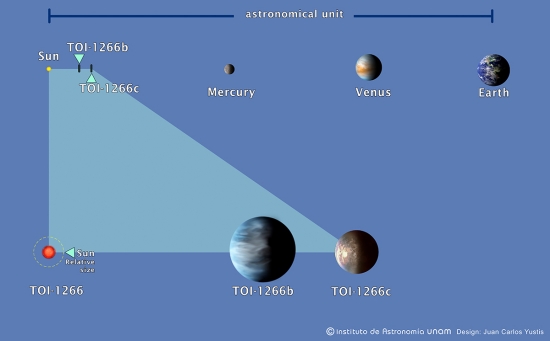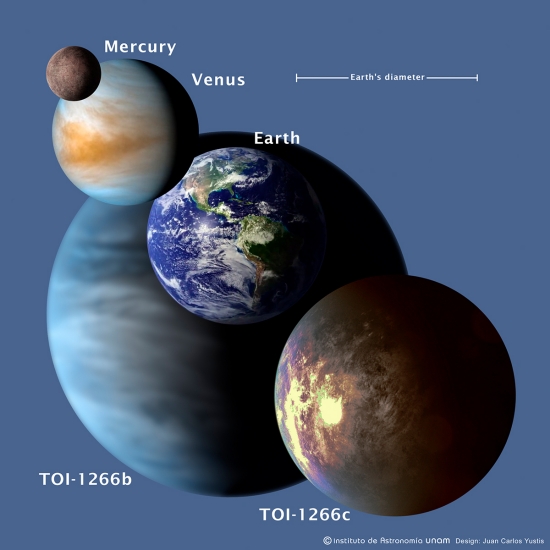The SAINT-EX telescope, operated by NCCR PlanetS, produces a nice resonance as I write this morning. The latter acronym stands for the National Centre of Competence in Research PlanetS, operated jointly by the University of Bern and the University of Geneva. The former, SAINT-EX, identifies a project called Search And characterIsatioN of Transiting EXoplanets, and the team involved explicitly states that they shaped their acronym to invoke Antoine de Saint-Exupéry, legendary aviator and author of, among others, Wind, Sand and Stars (1939), Night Flight (1931) and Flight to Arras (1942).

I’ve talked about Saint-Exupéry now and again throughout the history of Centauri Dreams, not only because he was an inspiration for my own foray into flying, but also because for our interstellar purposes he is credited with this inspirational thought:
“If you want to build a ship, don’t drum up the men to gather wood, divide the work and give orders. Instead, teach them to yearn for the vast and endless sea.”
I say Saint-Exupéry is ‘credited’ with this because it seems to be a condensation of a longer passage that appeared in his 1948 title La Citadelle and I’ve never been able to track the oft-quoted short version down to an original in this specific form. No matter, it’s a grand thought and it plays to our passions as explorers and mappers of new worlds.
So good for NCCR PlanetS for the nod to a favorite writer, and thanks for its recent work at TOI-1266, a red dwarf now known to host at least two planets. The confirmation was achieved with the SAINT-EX robotic 1-meter telescope that the project operates in Mexico; the paper was recently published in Astronomy & Astrophysics. TOI identifies a TESS Object of Interest, meaning the object had been considered promising for follow-up work to validate the candidate signatures as planets. The paper on TOI-1266 provides the needed confirmation.
Here’s what we know: TOI-1266 b is an apparent sub-Neptune about two and a half times the diameter of the Earth that orbits the primary in 11 days. TOI-1266 c is closer in size to a ‘super-Earth’ in being about one and a half times the size of our planet in a 19-day orbit.
The orbits are circular, co-planar and stable. Referring to the more than 3000 transiting planets thus far identified, which includes 499 with more than a single transiting world, the authors discuss distinctive planetary populations. Both planets at TOI-1266 are found at what lead author Brice-Olivier Demory calls the ‘radius valley,’ for reasons explained in the paper:
This large sample of transiting exoplanets allows for in-depth exploration of the distinct exoplanet populations. One such study by Fulton et al. (2017) identified a bi-modal distribution for the sizes of super-Earth and sub-Neptune Kepler exoplanets, with a peak at ?1.3 R? and another at ?2.4 R?. The interval between the two peaks is called the radius valley and it is typically attributed to the stellar irradiation received by the planets, with more irradiated planets being smaller due to the loss of their gaseous envelopes.

Image: Size of TOI-1266 system compared to the inner solar system at a scale of one astronomical unit, the distance between the Earth and the Sun. The orbital distances of the two exoplanets discovered around the star TOI-1266, which is half of the size of the Sun, are smaller than Mercury’s orbital distance. TOI-1266 b, the closest planet to the star at a distance of 0.07 astronomical units, has a diameter of 2.37 times that of Earth’s and is therefore considered a sub-Neptune. TOI-1266 c, at 0.01 astronomical units from its star and with 1.56 times the Earth’s diameter, is considered a super-Earth. For each planetary system, the star’s diameter and the orbital distances to its planets are shown in scale. The relative diameter of all planets of both systems are on scale, being TOI-1266 b the largest planet and Mercury the smallest. The zoom-in to TOI-1266, in the lower part of the image, shows that the irradiation received by TOI-1266 c from its star is 21% larger than the irradiation received by Venus from the Sun in the upper part of the image. © Institute of Astronomy, UNAM/ Juan Carlos Yustis.
It’s useful to have a super-Earth and a sub-Neptune in the same system because this allows for tighter constraints on formation models. The paper argues that this will be “a key system to better understand the nature of the radius valley around early to mid-M dwarfs.”
It’s also interesting that TOI-1266’s small size and relative proximity (about 117 light years) make it a possible target for atmospheric studies with future instruments. The authors show that the James Webb Space Telescope should be able to operate well above the observatory’s noise floor level in performing transmission spectroscopy here (i.e., viewing changes in the star’s light as the either planet moves first in front of and then is eclipsed by the star). The TOI-1266 planets compare favorably to TRAPPIST-1b on this score, and the host star shows no evidence of significant starspots that might distort the signal of the exoplanet atmospheres.

Image: Direct comparison among the planets of TOI-1266 system with the interior planets of the solar system. © Institute of Astronomy, UNAM / Juan Carlos Yustis.
The paper is Brice-Olivier Demory et al., “A super-Earth and a sub-Neptune orbiting the bright, quiet M3 dwarf TOI-1266,” Astronomy & Astrophysics Volume 642 (2 October 2020). Abstract.



There was a typo in one figure above, so I went to https://arxiv.org/pdf/2009.04317.pdf and found figures of 0.0736 and 0.1058 AU for b and c semimajor axes respectively. Making several unwarranted assumptions, that gives a minimum distance of 0.0322 AU between them = 4.82 Gm, and the larger planet is 15.1 Mm, so its disk is tan-1(1/319) or 0.18 degrees, unless I fouled up. Less than half the size of a full Moon, but probably much brighter per unit area given the Moon’s low albedo – likely to be something the local biology would notice, especially if there are some interplanetary tidal effects. The equilibrium temperature for c was 344 K, quite toasty by Earth standards but maybe not incompatible with dark/twilight zone life? The authors sounded pretty sure about tidal locking, though I don’t know I was convinced.
These exoplanets are so large, so they most likely have some atmosphere. They are also outside the life belt of their star and inside the snow line. The chemical composition of the atmospheres should tells us a lot about them.
They are in the steam zone not the snow line, they both get more irradiation than venus.
TOI-1266c doesn’t seem very suitable for life because it receives more light than Venus, likely lost a great deal of atmosphere to red dwarf flares, and is expected to be subject to a tidal lock. Still… these factors might tend to cancel each other out. If the dark side has water and a weak atmosphere that is only partly warmed from the light side, maybe it could have Earthlike temperatures after all.
The oddest thing you’d notice when landing on such a planet might be the forests of the endless night. On TOI-1266c, it would not be the Sun that is the source of all life, but the black starry sky. Working as anti-solar cells (see https://www.ucdavis.edu/news/anti-solar-cells-photovoltaic-cell-works-night ) the plants might generate a quarter of the power of Earth plants, but they would do so 24 hours a … 24-hour period. All the same biological imperatives to grow high and harvest the available darkness would still apply – this has led lycopods, gymnosperms, monocots and dicots all to evolve forms we would reasonably think of as “trees”, and so there’s no reason not to expect the same there.
Vision might be more complicated. With little light, it’s hard to picture evolving eyes sensitive enough to work in starlight. Hard but not impossible. To start with, there’s the small bright disc of TOI-1266b in the sky, possibly comparable to a full Moon in intensity if its albedo is very high like Venus. That might be enough to promote evolution of sensors capable of detecting the cycle, particularly if the passing planet raises enough of a tide that there are reasons for organisms to want to notice it.
The weirder part … well, the plants emit near-IR to the sky. If a leaf is facing the leaf of another plant above it, it gets about as much near-IR back and the antiphotosynthesis collapses. So leaves would tend to respond to darkness just like Earth plants respond to light. So imagine what happens if an organism develops a little ocellus of photoreceptors focused on a point in the distance – it would see when the infrared at the point it is focused on changes. These signals could then be controlled at the eye, by reversing the antiphotosynthesis much as animals have done to bacteriorhodopsin. I imagine that natural philosophers on that planet perhaps considered that eyes simply sense light from an external source, before appreciating their error and recognizing that sight is the result of visual rays emitted from the retina. :)
I didn’t look at the diagram carefully enough. These exoplanets are in front of the life belt so they are hot. I wonder what the maximum distance in light years the JWST can use transmission spectroscopy. I hope if the JWST works we use the star shade option right away and also I wonder how many light years would be it’s maximum range with a star shade?
Australian invention to make it easier to find ‘new Earths’.
21 October 2020
Photonics combined with AI will help decipher the ‘twinkle’ of stars.
University of Sydney scientists have developed a sensor that will help decipher the ‘twinkle’ of stars and allow for ground-based exploration of exoplanets. Their invention will be deployed in one of the world’s largest telescopes at Mauna Kea, Hawaii.
Australian scientists have developed a new type of sensor to measure and correct the distortion of starlight caused by viewing through the Earth’s atmosphere, which should make it easier to study the possibility of life on distant planets.
Using artificial intelligence and machine learning, University of Sydney optical scientists have developed a sensor that can neutralise a star’s ‘twinkle’ caused by heat variations in the Earth’s atmosphere. This will make the discovery and study of planets in distant solar systems easier from optical telescopes on Earth.
“The main way we identify planets orbiting distant stars is by measuring regular dips in starlight caused by planets blocking out bits of their sun,” said lead author Dr Barnaby Norris, who holds a joint position as a Research Fellow in the University of Sydney Astrophotonic Instrumentation Laboratory and in the University of Sydney node of Australian Astronomical Optics in the School of Physics.
“This is really difficult from the ground, so we needed to develop a new way of looking up at the stars. We also wanted to find a way to directly observe these planets from Earth,” he said.
“This is really difficult from the ground, so we needed to develop a new way of looking up at the stars. We also wanted to find a way to directly observe these planets from Earth,” he said.
The team’s invention will now be deployed in one of the largest optical telescopes in the world, the 8.2-metre Subaru telescope in Hawaii, operated by the National Astronomical Observatory of Japan.
“It is really hard to separate a star’s ‘twinkle’ from the light dips caused by planets when observing from Earth,” Dr Norris said. “Most observations of exoplanets have come from orbiting telescopes, such as NASA’s Kepler. With our invention, we hope to launch a renaissance in exoplanet observation from the ground.”
To solve this problem, the scientific team in the School of Physics developed a ‘photonic wavefront sensor’, a new way to allow the exact distortion caused by the atmosphere to be measured, so it can then be corrected by the telescope’s adaptive optics systems thousands of times a second.
“This new sensor merges advanced photonic devices with deep learning and neural networks techniques to achieve an unprecedented type of wavefront sensor for large telescopes,’ Dr Norris said.
“Unlike conventional wavefront sensors, it can be placed at the same location in the optical instrument where the image is formed. This means it is sensitive to types of distortions invisible to other wavefront sensors currently used today in large observatories,” he said.
https://www.sydney.edu.au/news-opinion/news/2020/10/21/Australian-invention-to-find-new-Earths-exoplanets-photonics-AI.html
https://www.naoj.org/Projects/SCEXAO/scexaoWEB/000home.web/indexm.html
An all-photonic focal-plane wavefront sensor.
Abstract
Adaptive optics (AO) is critical in astronomy, optical communications and remote sensing to deal with the rapid blurring caused by the Earth’s turbulent atmosphere. But current AO systems are limited by their wavefront sensors, which need to be in an optical plane non-common to the science image and are insensitive to certain wavefront-error modes. Here we present a wavefront sensor based on a photonic lantern fibre-mode-converter and deep learning, which can be placed at the same focal plane as the science image, and is optimal for single-mode fibre injection. By measuring the intensities of an array of single-mode outputs, both phase and amplitude information on the incident wavefront can be reconstructed. We demonstrate the concept with simulations and an experimental realisation wherein Zernike wavefront errors are recovered from focal-plane measurements to a precision of 5.1 × 10?3 ? radians root-mean-squared-error.
https://www.nature.com/articles/s41467-020-19117-w
Thanks
A very interesting article and comments :)
these are very interesting planets
Cheers Laintal